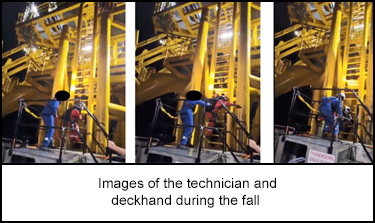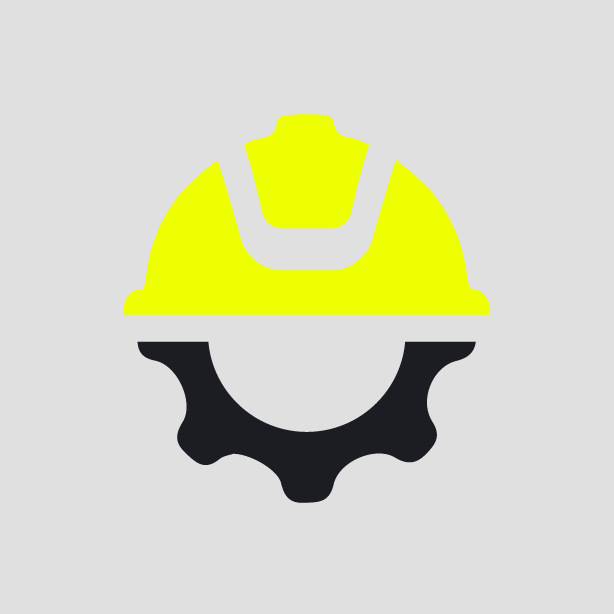-
What happened?
During night transfer from a Floating offshore wind turbine (FOWT) to a Crew transfer vessel (CTV), a technician fell while moving from the boat landing ladder to the vessel bow.
The CTV was moving due to swell conditions and dropped suddenly as the transferee stepped across.
The transferee became suspended on the Self-retractable lifeline (SRL).
A deckhand intervened quickly, lifting the transferee to reduce tension and disconnecting him safely from the SRL.
The transferee was safely recovered with no reported injury, but there was high potential for serious harm.
A similar event had occurred previously under similar conditions, indicating a pattern of risk.

-
Why did it happen?
Swell conditions at the time (Hs ~1.2m (3.9ft) / Hmax ~2.2m (7.2ft)) were near operational limits, and visibility was poor due to night-time transfer.
The CTV crew did not adequately monitor wave conditions or coordinate timing of transfer with vessel movement.
There was lack of clarity and consistency in instructions given to the transferee during the transfer.
Both CTV crew and some transferees lacked sufficient experience and confidence in offshore transfer procedures.
Safety rules were not assertively enforced by the CTV leadership.

-
What did they learn?
Transferees and CTV crew must receive clear, consistent instructions and be trained in safe offshore transfers.
Night transfers or transfers during marginal sea states require experienced personnel only.
A “buddy” system should be used to support less experienced personnel during transfers.
A marine expert should periodically review and assess CTV crew competence and transfer operations.
The CTV master must maintain authority and ensure all transfer decisions are followed promptly and without hesitation

-
Ask yourself or your crew
How do we ensure everyone involved in personnel transfers fully understands the procedure and timing?
What safeguards do we have in place to assess sea state and stop transfers when conditions deteriorate?
How are new or less experienced workers supported during high-risk operations like boat landings?
Are we confident that CTV crews are empowered and trained to enforce safety standards assertively?

Add to homescreen
Content name
Select existing category:
Content name
New collection
Edit collection
What happened?
During night transfer from a Floating offshore wind turbine (FOWT) to a Crew transfer vessel (CTV), a technician fell while moving from the boat landing ladder to the vessel bow.
The CTV was moving due to swell conditions and dropped suddenly as the transferee stepped across.
The transferee became suspended on the Self-retractable lifeline (SRL).
A deckhand intervened quickly, lifting the transferee to reduce tension and disconnecting him safely from the SRL.
The transferee was safely recovered with no reported injury, but there was high potential for serious harm.
A similar event had occurred previously under similar conditions, indicating a pattern of risk.

Why did it happen?
Swell conditions at the time (Hs ~1.2m (3.9ft) / Hmax ~2.2m (7.2ft)) were near operational limits, and visibility was poor due to night-time transfer.
The CTV crew did not adequately monitor wave conditions or coordinate timing of transfer with vessel movement.
There was lack of clarity and consistency in instructions given to the transferee during the transfer.
Both CTV crew and some transferees lacked sufficient experience and confidence in offshore transfer procedures.
Safety rules were not assertively enforced by the CTV leadership.
What did they learn?
Transferees and CTV crew must receive clear, consistent instructions and be trained in safe offshore transfers.
Night transfers or transfers during marginal sea states require experienced personnel only.
A “buddy” system should be used to support less experienced personnel during transfers.
A marine expert should periodically review and assess CTV crew competence and transfer operations.
The CTV master must maintain authority and ensure all transfer decisions are followed promptly and without hesitation
Ask yourself or your crew
How do we ensure everyone involved in personnel transfers fully understands the procedure and timing?
What safeguards do we have in place to assess sea state and stop transfers when conditions deteriorate?
How are new or less experienced workers supported during high-risk operations like boat landings?
Are we confident that CTV crews are empowered and trained to enforce safety standards assertively?
A technician fell during night transfer from a Floating offshore wind turbine to a Crew transfer vessel due to swell. He was safely recovered, but there was high potential for serious harm.











